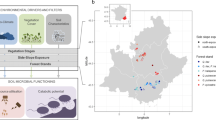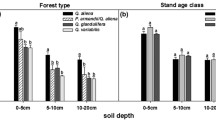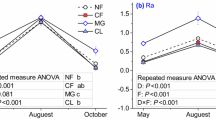Abstract
Microorganisms decompose organic substrates to obtain energy. This process releases carbon dioxide (CO2) and is the main cause of soil carbon release in terrestrial ecosystems. Fluctuations in microbial composition significantly affect net CO2 emissions in forests. Because factors are cross-correlated, addressing how they affect soil respiration (Rs), both directly and indirectly, is challenging. In this study, Rs-impacting soil properties, including soil organic carbon (SOC), soil organic nitrogen (SON), microbial diversity (Dsim, indicated by Simpson’s diversity index), and total microbial DNA concentration in natural beech forests were examined by structure equation modeling (SEM), which can explicitly evaluate the causal relationships among interacting variables. The results showed that decreasing Dsim, soil temperature, SOC, and SON clearly had direct and indirect effects on Rs under natural conditions. Increasing temperature was a primary factor and promoted a decrease in Rs during the growth season. Dsim was the only parameter with a direct positive effect on Rs, indicating that microbial diversity could accurately predict Rs. Soil nutrient factors indirectly affected Rs through Dsim, which was also affected by soil physical and chemical properties. Significant covariance between SON and Rs (0.42, p < 0.001) indicated multiple interacting variables affecting soil activity. Although the current study suggests that SEM can clarify complex functional processes related to Rs, future studies should consider additional impacting variables such as vegetation properties and enzyme dynamics.





Similar content being viewed by others
References
Abe M, Izaki J, Miguchi H, Masaki T, Makita A, Nakashizuka T (2002) The effects of Sasa and canopy gap formation on tree regeneration in an old beech forest, Nakashizuka. J Veg Sci 13:565–574
Allison SD, Wallenstein MD, Bradford MA (2010) Soil–carbon response to warming dependent on microbial physiology. Nature Geosci 3:336–340
Arctic Climate Impact Assessment Team (2004) Impacts of a warming arctic: arctic climate impact assessment. Cambridge University Press, Cambridge, pp 26–32
Bahn M, Rodeghiero M, Anderson-Dunn M, Dore S, Gimeno C, Drösler M, Williams M, Ammann C, Berninger F, Flechard C, Jones S, Balzarolo M, Kumar S, Newesely C, Priwitzer T, Raschi A, Siegwolf R, Susiluoto S, Tenhunen Wohlfahrt JG, Cernusca A (2008) Soil respiration in European grasslands in relation to climate and assimilate supply. Ecosystems 11:1352–1367
Baldrian P, Šnajdr J, Merhautová V, Dobiášová P, Cajthaml T, Valášková V (2013) Responses of the extracellular enzyme activities in hardwood forest to soil temperature and seasonality and the potential effects of climate change. Soil Biol Biochem 56:60–68
Balser TC, Wixon DL (2009) Investigating biological control over soil carbon temperature sensitivity. Global Change Biol 15:2935–2949
Bell TH, Klironmos JN, Henry AL (2010) Seasonal responses of extracellular enzyme activity and microbial biomass to warming and nitrogen addition. Soil Sci Soc Am J 74:820–828
Biasi C, Meyer H, Rusolimova O, Hämmerle R, Kaiser C, Baranyi C, Daims H, Lashchinsky N, Barsukov P, Richter A (2008) Initial effects of experimental warming on carbon exchange rates, plant growth and microbial dynamics of lichen-rich dwarf shrub tundra in Siberia. Plant Soil 307:191–205
Brahim N, Blavet D, Gallali T, Bernoux M (2011) Application of structural equation modeling for assessing relationships between organic carbon and soil properties in semiarid Mediterranean region. Environ Sci Technol 8:305–320
Burns RG, DeForest JL, Marxsen J, Sinsabaugh RL, Stromberger ME, Wallenstein MD, Weintraub MN, Zoppini A (2013) Soil enzymes in a changing environment: current knowledge and future directions. Soil Biol Biochem 58:216–234
De Angelis KM, Lindow SE, Firestone MK (2008) Bacterial quorum sensing and nitrogen cycling in rhizosphere soil. FEMS Microbiol Ecol 66:197–207
Fang C, Moncrieff JB (2001) The dependence of soil CO2 efflux on temperature. Soil Biol Biochem 33:155–165
Fierer N, Ladau J (2012) Predicting microbial distributions in space and time. Nat Methods 9:549–551
Frank H, David H, Kathrin S, Alf E, Björn L, Anja M, Beat FI, Tanya H, Stephan H (2013) Nine years of CO2 enrichment at the alpine tree line stimulates soil respiration but does not alter soil microbial communities. Soil Biol Biochem 57:390–400
Frey SD, Drijber R, Smith H, Meliio J (2008) Microbial biomass, functional capacity, and community structure after 12 years of soil warming. Soil Biol Biochem 40:2094–2907
Gärdenäs AI, Ågren GI, Bird JA, Clarholm M, Hallin S, Ineson P, Kätterer T, Knicker H, Nilsson SI, Näsholm T, Ogle S, Paustian K, Persson T, Stendahl J (2011) Knowledge gaps in soil carbon and nitrogen interactions—from molecular to global scale. Soil Biol Biochem 43:702–717
Geng Y, Wang YH, Yang K, Wang SP, Zeng H, Frank B, Kuehn P, Scholten T, He J (2012) Soil respiration in Tibetan alpine grasslands: belowground biomass and soil moisture, but not soil temperature, best explain the large-scale patterns. PLoS ONE 7:e34968
Gershenson A, Bader NE, Cheng WX (2009) Effects of substrate availability on the temperature sensitivity of soil organic matter decomposition. Global Change Biol 15:176–183
Giardina CP, Ryan MG (2000) Evidence that decomposition rates of organic carbon in mineral soil do not vary with temperature. Nature 404:858–861
Grace JB, Anderson TM, Smith MD, Seabloom E, Andelman SJ, Meche G, Weiher E, Allain LK, Jutila H, Sankaran M, Knops J, Ritchie M, Willig MR (2007) Does species diversity limit productivity in natural grassland communities? Ecol Lett 10:680–689
Grace JB, Anderson TM, Olff H, Scheiner SM (2010) On the specification of structural equation models for ecological systems. Ecol Monogr 80:67–87
Hakkenberg R, Churkina G, Rodeghiero M, Börner A, Steinhof A, Cescatti A (2008) Temperature sensitivity of the turnover times of soil organic matter in forests. Ecol Appl 18:119–131
Hamdi S, Moyano F, Sall S, Bernoux M, Chevallier T (2013) Synthesis analysis of the temperature sensitivity of soil respiration from laboratory studies in relation to incubation methods and soil conditions. Soil Biol Biochem 58:115–126
Hart SC (2006) Potential impacts of climate change on nitrogen transformations and greenhouse gas fluxes in forests: a soil transfer study. Global Change Biol 12:1032–1046
Hart SC, Perry DA (1999) Transferring soils from high- to low-elevation forests increases nitrogen cycling rates: climate change implications. Global Change Biol 5:23–32
Högberg P, Nordgren A, Buchmann N, Taylor AF, Ekblad A, Högberg MN, Nyberg G, Ottosson-Löfvenius M, Read DJ (2001) Large-scale forest girdling shows that current photosynthesis drives soil respiration. Nature 411:789–792
Ineson P, Cotrufo MF, Bol R, Harkness DD, Blum H (1996) Quantification of soil carbon inputs under elevated CO2: C3 plants in a C4 soil. Plant Soil 187:345–350
Joo SJ, Park SU, Park MS, Lee CS (2012) Estimation of soil respiration using automated chamber systems in an oak (Quercus mongolica) forest at the Nam-San site in Seoul, Korea. Sci Total Environ 416:400–409
Jussy JH, Colin-Belgrand M, Dambrine É, Ranger J, Zeller B, Bienaimé S (2004) N deposition, N transformation and N leaching in acid forest soils. Biol Chem 69:241–262
Kaiser C, Koranda M, Kitzler B, Fuchslueger L, Schnecker J, Schweiger P, Rasche F, Zechmeister-Boltenstern S, Sessitsch A, Richter A (2010) Belowground carbon allocation by trees drives seasonal patterns of extracellular enzyme activities by altering microbial community composition in a beech forest soil. New Phytol 187:843–858
Kakubari Y (1977) Distribution of primary productivity along the altitudinal gradient. JIBP Synth 16:201–212
Kanea ES, Valentinea DW, Michaelsonb GJ, Foxa JD, Ping CL (2006) Controls over pathways of carbon efflux from soils along climate and black spruce productivity gradients in interior Alaska. Soil Biol Biochem 38:1438–1450
Kasuya MCM, Masaka K, Igarashi T (1995) Mycorrhizae of Monotropastrum giobosum growing in a Fagus crenata forest. Mycoscience 36:461–464
Kimball BA, Conley MM (2009) Infrared heater arrays for warming field plots scaled up to 5-m diameter. Agric Forest Meteorol 149:721–724
Kitzler B, Zechmeister SB, Holtermann C, Skiba U, Butterbach BK (2006) Nitrogen oxides emission from two beech forests subjected to different nitrogen loads. Biogeosciences 3:293–310
Koranda M, Kaiser C, Fuchslueger L, Kitzler B, Sessitsch A, Zechmeister- Boltenstern S, Richter A (2013) Seasonal variation in functional properties of microbial communities in beech forest soil. Soil Biol Biochem 60:95–104
Krivtson V, Griffiths BS, Liddell K, Garside A, Salmond R, Bezginova T, Thompson J (2011) Soil nitrogen availability is reflected in the bacterial pathway. Pedosphere 21:26–30
Lam TY, Maguire D (2012) Structural equation modeling: theory and applications in forest management. Int J Forest Res 2012:1–16
Li LJ, You MY, Shi HA, Ding XL, Qiao YF, Han XZ (2013) Soil CO2 emissions from a cultivated Mollisol: effects of organic amendments, soil temperature, and moisture. Eur J Soil Biol 55:83–90
Liu HS (2013) Thermal response of soil microbial respiration is positively associated with labile carbon content and soil microbial activity. Geoderma 193–194:275–281
Lloyd J, Taylor JA (1994) On the temperature dependence of soil respiration. Funct Ecol 8:315–323
Luo YQ, Zhou XH (2006) Soil respiration and the environment. Academic Press, San Diego, pp 77–156
Luo YQ, Wan SQ, Hui DF, Wallace LL (2001) Acclimatization of soil respiration to warming in a tall grass prairie. Nature 413:622–625
Maire V, Alvarez G, Colombet J, Comby A, Despinasse R, Dubreucq E, Joly M, Lehours AC, Perrier V, Shahzad T, Fontaine S (2012) An unknown respiration pathway substantially contributes to soil CO2 emissions. Biogeosci Disc 9:8663–8691
Makiranta P, Laiho R, Fritze H, Hytonen J, Laine J, Minkkinen K (2009) Indirect regulation of heterotrophic peat soil respiration by water level via microbial community structure and temperature sensitivity. Soil Biol Biochem 41:695–703
Martina JG, Bolstadb PV, Ryu SR, Chen JQ (2009) Modeling soil respiration based on carbon, nitrogen, and root mass across diverse Great Lake forests. Agric Forest Meteorol 149:1722–1729
Michopoulos P, Baloutsos G, Economou A (2008) Nitrogen cycling in a mature mountainous beech forest. Silva Fenn 42:5–17
Misson L, Baldocchi DD, Black TA, Brunet Y, Curiel Y, Dorsey JR, Falk M, Granier A, Irvine MR, Jarosz N, Lamaud E, Launiainen S, Law BE, Longdoz B, Loustau D, McKay M, Paw UKT, Vesala T, Vickers D, Wilson KB, Goldstein AH (2007) Partitioning forest carbon fluxes with overstory and understory eddy covariance measurements: a synthesis based on FLUX-NET data. Agric Forest Meteorol 144:14–31
Mo WH, Lee MS, Masaki U, Motoko I, Nobuko S, Shigeru M, Hiroshi K (2005) Seasonal and annual variations in soil respiration in a cool-temperate deciduous broad-leaved forest in Japan. Agric Forest Meteorol 134:81–94
Mohanty RB, Panda T (2011) Soil respiration and microbial population in a tropical deciduous forest soil of Orissa. Flora 206:1040–1044
Muyzer G, de Waal EC (1994) Determination of the genetic diversity of microbial communities using DGGE analysis of PCR amplified 16S rRNA. Nato Sci Ser 35:207–214
Nakashizuka T (1987) Regeneration dynamics of beech forest in Japan. Vegetation 69:169–175
Nannipieri P, Ascher J, Ceccherini MT, Landi L, Pietramellara G, Renella G, Valori F (2007) Microbial diversity and microbial activity in the rhizosphere. Cienc Suelo 2:89–97
Niinisto SM, Silvola J, Kellomaki S (2004) Soil CO2 efflux in a boreal pine forest under atmospheric CO2 enrichment and air warming. Global Change Biol 10:1363–1376
Oberbauer SF, Tweedie CE, Welker JM, Fahnestock JT, Henry GHR, Webber PJ, Hollister RD, Walker MD, Kuchy A, Elmore E, Starr G (2007) Tundra CO2 fluxes in response to experimental warming across latitudinal and moisture gradients. Ecol Monogr 77:221–238
Okaura T, Harada K (2002) Phylogeographical structure revealed by chloroplast DNA variation in Japanese Beech (Fagus crenata Blume). Heredity 88:322–329
Ouyang Y, Li XY (2013) Recent research progress on soil microbial responses to drying-rewetting cycles. Acta Ecol Sin 33:1–6
Radojkovic D, Kušic J (2000) Macroprolactin reactivities in prolactin assays: an issue for clinical laboratories and equipment manufacturers. Clin Chem 46:884–885
Read DJ, Leake JR, Perez-Moreno J (2004) Mycorrhizal fungi as drivers of ecosystem processes in heathland and boreal forest biomes. Can J Bot 82:1243–1263
Rinke C, Schwientek P, Sczyrba A, Ivanova NN, Anderson IJ, Cheng JF, Darling A, Malfatti S, Swan BK, Gies EA, Dodsworth JA, Hedlund BP, Tsiamis G, Sievert SM, Liu WT, Eisen JA, Hallam SJ, Kyrpides NC, Stepanauskas R, Rubin EM, Hugenholtz P, Woyke T (2013) Insights into the phylogeny and coding potential of microbial dark matter. Nature 499:431–437
Rinnan R, Michelsen A, Jonasson S (2008) Effects of litter addition and warming on soil carbon, nutrient pools and microbial communities in a subarctic heath ecosystem. Appl Soil Ecol 39:271–281
Rinnan R, Michelsen A, Bååth E (2011) Long-term warming of a subarctic heath decreases soil bacterial community growth but has no effects on its temperature adaptation. Appl Soil Ecol 47:217–220
Rodeghiero M, Cescatti A (2005) Main determinants of forest soil respiration along an elevation/temperature gradient in the Italian Alps. Global Change Biol 11:1024–1041
Saigusa N, Yamamoto S, Murayama S, Kondo H, Nishimura N (2002) Gross primary production and net ecosystem production of a cool-temperate deciduous forest estimated by the eddy covariance method. Agric Forest Meteorol 112:203–215
Schindlbachera A, Rodlera A, Kuffnerb M, Kitzlera B, Sessitschb A, Boltensterna SZ (2011) Experimental warming effects on the microbial community of a temperate mountain forest soil. Soil Biol Biochem 43:1417–1425
Schulze ED (2000) The carbon and nitrogen cycle of forest ecosystems. In: Schulze, E.D. (ed.), Carbon and nitrogen cycling in European forest ecosystems. Ecol Studies, vol 142, pp 3–13
Strömgren M, Linder S (2002) Effects of nutrition and soil warming on stem-wood production in a boreal Norway spruce stand. Global Change Biol 8:1195–1204
Sullivan BW, Kolb TE, Hart SC, Kaye JP, Dore S, Montes-Helu M (2008) Thinning reduces soil carbon dioxide but not methane flux from southwestern USA ponderosa pine forests. Forest Ecol Manag 255:4047–4055
Talbot JM, Allison SD, Treseder KK (2008) Decomposers in disguise: mycorrhizal fungi as regulators of soil C dynamics in ecosystems under global change. Funct Ecol 22:955–963
Tang J, Baldocchi DD, Xu L (2005) Tree photosynthesis modulates soil respiration on a diurnal time scale. Global Change Biol 11:1298–1304
Tang YS, Wang L, Jia JW, Xia FH, Le YQ, Chen XiZ, Sun Y (2011) Response of soil microbial community in Jiuduansha wetland to different successional stages and its implications for soil microbial respiration and carbon turnover. Soil Biol Biochem 43:638–646
Thomson BC, Ostle NJ, McNamara NP, Whiteley AS, Griffiths RI (2010) Effects of sieving, drying and rewetting upon soil bacterial community structure and respiration rates. J Microbiol Methods 83:69–73
von Lützow M, Kögel-Knabner I (2009) Temperature sensitivity of soil organic matter decomposition-what do we know? Biol Fert Soils 46:1–15
Wallenstein MD, McMahon SK, Schimel JP (2009) Seasonal variation in enzyme activities and temperature sensitivities in Arctic tundra soils. Global Change Biol 15:1631–1639
Welker JM, Fahnestock JT, Henry G, O’dea K, Chimner RA (2004) CO2 exchange in the Canadian high arctic: response to long-term warming. Global Change Biol 10:1981–1995
Whitby TG, Madrith MD (2013) Native temperature regime influences soil response to simulated warming. Soil Biol Biochem 60:202–209
Wu X, Yao Z, Brüggemann N, Shen ZY, Wolf B, Dannenmann M, Zheng X, Butterbach-Bahl K (2010) Effects of soil moisture and temperature on CO2 and CH4 soil-atmosphere exchange of various land use/cover types in a semi-arid grassland in Inner Mongolia, China. Soil Biol Biochem 42:773–787
Xu X, Sherry RA, Niu SL, Zhou JH, Luo YQ (2012) Long-term experimental warming decreased labile soil organic carbon in a tall grass prairie. Plant Soil 361:307–315
Yuste JC, Nagy M, Janssens IA, Carrara A, Ceulemans R (2005) Soil respiration in a mixed temperate forest and its contribution to total ecosystem respiration. Tree Physiol 25:609–619
Yuste CJ, Ma S, Baldocchi DD (2010) Plant–soil interactions and acclimation to temperature of microbial-mediated soil respiration may affect predictions of soil CO2 efflux. Biol Chem 98:127–138
Zhang XY, Meng XJ, Gao LP, Sun XM, Fan JJ, Xu LJ (2010) Potential impacts of climate warming on active soil organic carbon contents along natural altitudinal forest transect of Changbai Mountain. Acta Ecol Sin 30:113–117
Zhang SX, Lia Q, Zhang XP, Wei K, Chen LJ, Liang WJ (2012) Effects of conservation tillage on soil aggregation and aggregate binding agents in black soil of Northeast China. Soil Till Res 124:196–202
Zhang SX, Lia Q, Lüa Y, Zhang XP, Liang WJ (2013) Contributions of soil biota to C sequestration varied with aggregate fractions under different tillage systems. Soil Biol Biochem 62:147–156
Zhao X, Wang Q, Yoshitaka K (2009) Stand-scale spatial patterns of soil microbial biomass in natural cold-temperate beech forests along an elevation gradient. Soil Biol Biochem 41:1466–1474
Zhao X, Wang Q, Yoshitaka K (2011) Seasonal dynamics of soil microbial biomass C shows close correlation with environmental factors in natural Fagus crenata forests. Acta Agric Scand B S P 61:322–332
Ziegler SE, Billings SA, Lane CS, Li JW, Fogel ML (2013) Warming alters routing of labile and slower-turnover carbon through distinct microbial groups in boreal forest organic soils. Soil Biol Biochem 60:23–32
Acknowledgments
We thank the members of the laboratories of Silviculture and Macroecology, Shizuoka University, Japan for their help with fieldwork. This study was partly supported by the Japan Science and Technology Agency (JST) Environmental Leadership Program (Grant No. 016100012).
Author information
Authors and Affiliations
Corresponding author
About this article
Cite this article
Lu, S., Katahata, S., Naramoto, M. et al. Controlling factors of temporal variation of soil respiration in a natural beech forest as revealed by natural incubation experiments. Ecol Res 29, 789–799 (2014). https://doi.org/10.1007/s11284-014-1158-x
Received:
Accepted:
Published:
Issue Date:
DOI: https://doi.org/10.1007/s11284-014-1158-x




